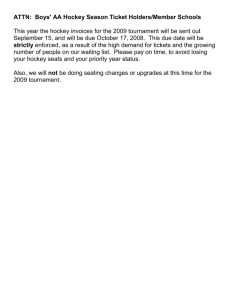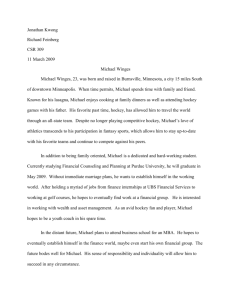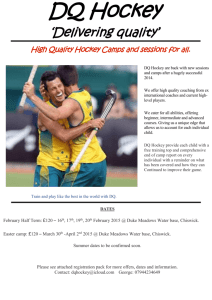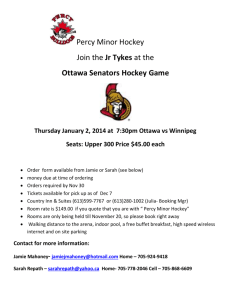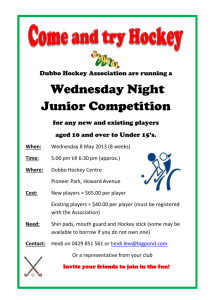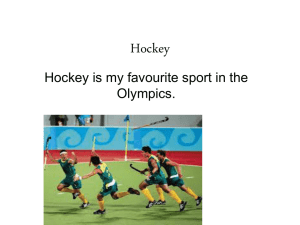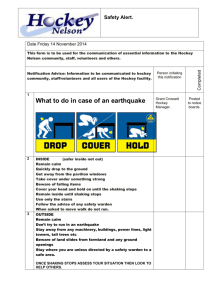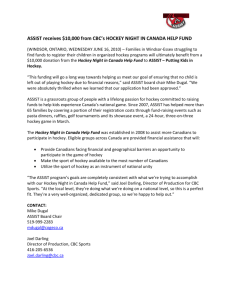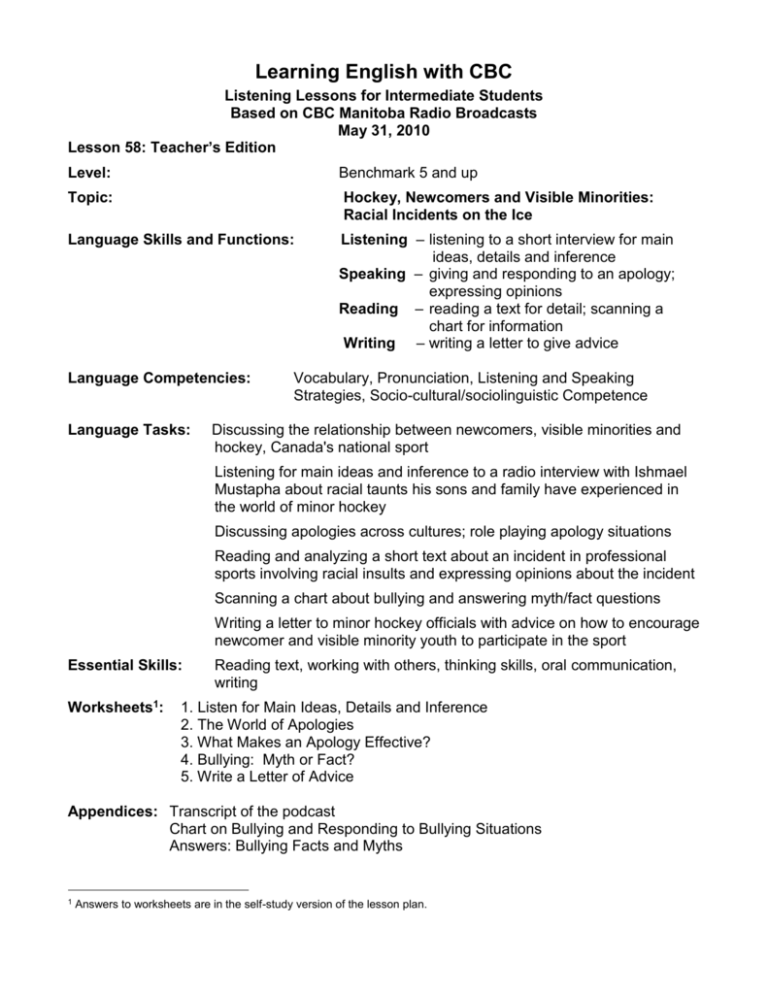
Learning English with CBC
Listening Lessons for Intermediate Students
Based on CBC Manitoba Radio Broadcasts
May 31, 2010
Lesson 58: Teacher’s Edition
Level:
Benchmark 5 and up
Topic:
Hockey, Newcomers and Visible Minorities:
Racial Incidents on the Ice
Language Skills and Functions:
Language Competencies:
Language Tasks:
Listening – listening to a short interview for main
ideas, details and inference
Speaking – giving and responding to an apology;
expressing opinions
Reading – reading a text for detail; scanning a
chart for information
Writing – writing a letter to give advice
Vocabulary, Pronunciation, Listening and Speaking
Strategies, Socio-cultural/sociolinguistic Competence
Discussing the relationship between newcomers, visible minorities and
hockey, Canada's national sport
Listening for main ideas and inference to a radio interview with Ishmael
Mustapha about racial taunts his sons and family have experienced in
the world of minor hockey
Discussing apologies across cultures; role playing apology situations
Reading and analyzing a short text about an incident in professional
sports involving racial insults and expressing opinions about the incident
Scanning a chart about bullying and answering myth/fact questions
Writing a letter to minor hockey officials with advice on how to encourage
newcomer and visible minority youth to participate in the sport
Essential Skills:
Worksheets1:
Reading text, working with others, thinking skills, oral communication,
writing
1. Listen for Main Ideas, Details and Inference
2. The World of Apologies
3. What Makes an Apology Effective?
4. Bullying: Myth or Fact?
5. Write a Letter of Advice
Appendices: Transcript of the podcast
Chart on Bullying and Responding to Bullying Situations
Answers: Bullying Facts and Myths
1
Answers to worksheets are in the self-study version of the lesson plan.
Manitoba Memo
Is ice hockey a "uniter" in the Canadian mosaic? How important is it that
newcomers to Manitoba understand the never-ending conversation about bringing an
NHL team back to Winnipeg? As the country is once again caught up in the Stanley Cup
playoffs, a new study2 suggests that hockey offers immigrants to Canada a public way to
show how they identify with Canadian culture and their new country.
The study found that interest in watching hockey is higher than the Canadian
average in some immigrant communities. For example, Italian and Arab Canadians are
among the sport's most avid fans. In Toronto, the CBC hired Parminder Singh to
broadcast Toronto Maple Leaf games in Punjabi, cultivating an interest in the sport in a
population where hockey has no roots at all.
Clearly, new Canadians are watching this country's national sport, but are they
actually playing it? The answer to that question appears to be "not yet." Soccer is the
sport of many new Canadians. Statistics show that as youth soccer participation has
soared over the past ten years, hockey registration has dropped dramatically. Minor
hockey leagues across Canada are facing a stark reality. To survive, they need to recruit
players from a new demographic. They need to persuade new Canadians that hockey is
a great sport to play, as well as watch.
There are many reasons why hockey is not the chosen sport of newcomers. First and
foremost, it's unfamiliar to many as it is not played in their home country. It's expensive to
play, especially when compared to soccer. Hockey is perceived by some as an
aggressive and dangerous sport. And last, but not least, there's a lack of diversity among
players. The skin colour of professional and minor hockey is overwhelmingly white. As a
result, the sport can feel cliquish and unwelcoming.
This is not a new phenomenon in sport. Other sports, like baseball and basketball,
have diversified their player ranks over time. And that's the path hockey hopes to follow
as officials begin to address the barriers newcomers face to becoming involved in the
game.
Perhaps, as has been the case in other sports, it will be role models like the young,
talented Montreal Canadians player P.K. Subban, who will inspire more new Canadians
to get involved in hockey. Time will tell!
Pre-listening activities
1. Discuss as a class
Is ice hockey played in your country?
What sports are popular in your country? Is there a national sport? What is it?
Have you ever been to a hockey game? Watched hockey on TV? What are your
overall impressions of hockey as a sport? How would you describe it?
Is it important for newcomers to Canada to understand something about hockey?
Why or why not?
2
Sources: http://www.theglobeandmail.com/news/national/the-great-melting-rink/article1576685/ and
http://www.faceoff.com/hockey/teams/toronto-maple-leafs/story.html?id=92809f78-33d3-430f-a6c9-226109f553d1
Hockey, Newcomers and Visible Minorities: Racial Incidents on the Ice
Learning English with CBC Page 2 of 19
Is it important for newcomer youth to consider playing hockey? Why or why not?
Competition in youth minor sport and professional sport doesn't always bring out
the best in players, parents, coaches or fans. There are many examples of
incidents where a fight breaks out or personal or racial insults are exchanged
during or after a game. What do you think of this kind of behaviour in sport? Is it
just part of the game? Why or why not?
2. Vocabulary
Elicit or present key vocabulary that students need to understand prior to listening to the
podcast (see suggested vocabulary and explanations which follow). You can write the
words on the board and elicit possible meanings from the class or break students into
groups and give each group a few words to review. Groups can then present the
vocabulary to the rest of the class. You can also ask students to mark the syllables and
stress for each word, identify word families and practise pronouncing the words. You
may want to ask students to think of sentences that use the new vocabulary. If your
students keep a vocabulary journal, they can copy the vocabulary into their journal.
Vocabulary
hockey-crazed
To be crazy or passionate about watching or
playing hockey.
minor hockey
A term used to describe amateur or nonprofessional hockey played by youth under the age
of 16.
(belong to its) ranks
To belong to an organization or group. For
example, the members of a minor hockey or soccer
league are said to belong to the ranks of that
particular sports organization.
racial taunt
To upset someone with teasing, a remark or joke
about their race.
an incident
A specific event, happening or occurrence that
takes place. For example, in sports, events that
upset players, coaches or fans are often referred to
as incidents.
a face-off
A method of starting play in ice hockey, lacrosse,
and other games where an official drops the puck or
ball between two opposing players. Each player
tries to control it to give their team an advantage.
the "n" word
The word nigger is seen as taboo and as a racial
slur, so instead of actually saying the offensive
word, people will refer to it as the "n" word.
f-ing
An abbreviation of common swear word used in
English. Also referred to as the "f" word.
Hockey, Newcomers and Visible Minorities: Racial Incidents on the Ice
Learning English with CBC Page 3 of 19
Abbreviated expressions are used to avoid saying
the actual word, which is seen as impolite or
inappropriate.
to shrug it off
To respond to an incident in sports with a shrug of
your shoulders, ignore what has happened and
continue to play the game.
to shut down
To stop doing something or stop being involved in
something.
(to be) degraded
To be treated without respect. To lose respect for
yourself.
(to be) insulted
To be the recipient of a remark or action that was
deliberately rude, insulting or offensive.
racial discrimination
To treat someone or a group differently or unfairly
due to their race.
3. Predict what the podcast is about
In this story, Ishmael Mustapha talks to Terry MacLeod about racial incidents that his
sons and family have experience at youth hockey games. Ask students what kinds of
emotions they would expect Ishmael to express when he talks to Terry about these
incidents.
I think he'll be ...upset about what happened.
He might be...concerned about what happened.
He could be...happy about how the incidents were resolved.
Maybe he'll be...angry.
I expect he'll be...offended.
I don't know what kind of emotions he'll express.
While-listening activities
1. Introduce the podcast
Tell students that in this podcast, they will hear three speakers. They will hear:
Marcy Markusa – host
Terry MacLeod – interviewer
Ishmael Mustapha – parent
Play the podcast for the first time.
Hockey, Newcomers and Visible Minorities: Racial Incidents on the Ice
Learning English with CBC Page 4 of 19
2. Listen for main ideas, details and inference
Hand out Worksheet 2. Ask students to work with a partner to complete it. Discuss the
answers as a class.
3. Use of taboo words
Ask students if they have taboo or swear words in their languages. Explain that in
English, there are three traditional categories of bad words. The first category is
religious words, the second is words referring to body functions and the third, which is
considered by many to be the most offensive, are words referring to sexual acts or
organs. Today there is a fourth category of taboo words. It consists of words that relate
to race or sexuality.
However, what is and isn't considered taboo in English is constantly evolving. Many
words which were once taboo are now viewed as slang. The words that continue to be
taboo are words that the majority of the population still finds offensive or unacceptable.
In English, when people want to talk about a taboo word but not actually use the word,
they sometimes use alternative expressions or abbreviations. These expressions are
universal - everyone knows what taboo word they are referring to. Ishmael uses two
examples in this interview, as follows:.
the "n" word, which refers to "nigger"
The word "nigger" has its origins in several languages. In a neutral context, it meant the
colour black. But historically, the word is linked to slavery. It was used to denote hatred
and repulsion toward Africans and African Americans and to mock or stereotype. It is
this historical use of the word which has made it taboo.
"f-ing" or the "f" word
Although this word, which refers to a sexual act, is used frequently, it is still considered
rude and offensive by many. It is generally not heard on radio or TV, except in its
abbreviated form.
Ask students if they have similar ways to talk about taboo words in their language
without actually saying them!
4. Using Pauses in Spoken English
Listen to Terry's last question and Ishmael's answer one more time. Note the long
pause before Ishmael answers. Ask students why they think Ishmael paused for such a
long time before he answered. How does that long pause affect them as listeners? Ask
students in what kinds of situations they have noticed pauses used in spoken English.
Ask if they use pauses in their language and how they use them.
Hockey, Newcomers and Visible Minorities: Racial Incidents on the Ice
Learning English with CBC Page 5 of 19
After-listening activities
1. Review pre-listening predictions
Ask students whether they were able to correctly predict the emotions Ishmael
expresses in his conversation with Terry.
Extension activities
1. Language to use in an apology
Hand out Worksheet 1 and review it with students. Ask students for examples from
their culture of when/how people apologize. How does this differ from what they have
observed in Canada?
Ask students to work in pairs. Collect the examples of apology situations from students
and each pair select one from the bag/hat to prepare as a role play to perform for their
classmates.
2. Analyze and discuss an apology which resulted from an incident in professional sport
Hand out Worksheet 3 and review the instructions with the class. Have students work
in small groups.
Discuss the answers to the questions under Task 3 as a class.
3. Scan a chart and decide whether statements about bullying are myth or fact
Hand out Appendix 2 and Worksheet 4. Have students work with a partner. Discuss
the answers to Worksheet 4 as a class.
There are expanded answers for Worksheet 4 in Appendix 3.
4. Write a letter to minor hockey officials on how they can encourage newcomer and visible
minority youth to play hockey
Hand out Worksheet 5. Ask students to work with a partner, but each student can write
their own letter. Ask students to read their letters aloud to the class.
Hockey, Newcomers and Visible Minorities: Racial Incidents on the Ice
Learning English with CBC Page 6 of 19
Want to know more…
For more information on hockey and new Canadians, go to the following CBC sports link:
www.cbc.ca/sports/hockey/ourgame/story/2009/01/09/minorities-minor-hockey.html
There are many sites with information on bullying. Here are some of them:
The Canadian Children's Rights Council website:
www.canadiancrc.com/Bullying_Canada_Resources_Provincial_Programs.aspx
The Canadian Safe Schools Network: www.cssn.org
Government of Manitoba and Safe Schools Manitoba:
http://www.edu.gov.mb.ca/k12/safe_schools/index.html
The Centre for Children and Families in the Justice System: www.lfcc.on.ca/bully.htm
The Kids Help Phone: www.kidshelp.sympatico.ca/en
The Red Cross program RespectED: Violence & Abuse Prevention has a section on
bullying: http://www.redcross.ca/article.asp?id=294
The information on myths and facts is from:
The Promoting Relationships and Eliminating Violence Network (PREVNet)
www.prevnet.ca/Home/tabid/36/language/en-US/Default.aspx
and from:
http://www.bullying.org
CBC does not endorse and is not responsible for the content of external websites
Hockey, Newcomers and Visible Minorities: Racial Incidents on the Ice
Learning English with CBC Page 7 of 19
Worksheet 1: Listen for Main Ideas, Details and Inference
Sometimes when we listen, we are listening for important details that help us to understand a
situation. Sometimes we are listening for the main ideas or for inference. When you listen to
the interview this time, listen for main ideas, details and inference. Read the questions with
your partner and select the best answer for each question. The first one is completed for you
as an example.
1
2
All of the incidents Ishmael
talks about _________.
Ishmael's sons have________.
3
The recent racial taunts have
_________.
4
Ishamel has __________about
his sons continuing to play
hockey.
5
Ishmael believes that nonwhite parents should
________________.
6
Based on Ishmael's
experience, it appears that
minor hockey _____________
of welcoming player from
different ethnic backgrounds.
a) happened in 2010
b) happened in 2009
c) happened last month
d) all of the above
e) none of the above
a) frequently been exposed to racial taunts on the ice
b) occasionally been exposed to racial taunts on the ice
c) rarely been exposed to racial taunts on the ice
d) all of the above
e) none of the above
a) affected his son's self-esteem
b) meant his son doesn't always feel like playing hockey
c) upset his son
d) all of the above
e) none of the above
a) strong feelings
b) mixed feelings
c) confused feelings
d) all of the above
e) none of the above
a) encourage their children to play hockey
b) think about whether they and their children can
handle the hockey environment
c) make sure their children do not play hockey
d) all of the above
e) none of the above
a) does a very good job
b) does a very poor job
c) needs to do a better job
d) all of the above
e) none of the above
Hockey, Newcomers and Visible Minorities: Racial Incidents on the Ice
Learning English with CBC Page 8 of 19
Worksheet 2: The World of Apologies
An apology is when we tell someone we are sorry for having done something that caused
inconvenience, unhappiness or was hurtful. When and how we make apologies differs from
one culture to the next. Here are a few examples:
1. In one culture, you may be expected to apologize if you sneeze, but not if you burp. In
another culture, the expectation may be the opposite.
2. In some cities, you may be expected to apologize if you step on a person's foot in the
subway. In another city, this may happen so often people no longer apologize, although
they may say "excuse me."
3. In one culture, someone might apologize if they take the job of a colleague who is retiring in
order to show respect. In another culture, someone who takes the job of a retiring colleague
would never think of apologizing.
The chart below provides examples of expressions we use to make apologies, explain our
behaviour and respond to apologies.
To make an apology
I'm sorry.
I'm very sorry.
I'm terribly sorry.
Excuse me.
Pardon me.
I apologize.
To explain ourselves
I wasn't feeling well yesterday.
I didn't see you.
It won't happen again.
I'll be more careful next time.
It was my fault.
I'm responsible for what happened.
I was upset.
I wasn't thinking about what I was
saying/doing.
I was wrong.
What I did/said was unacceptable.
To respond to an apology
That's okay.
No problem.
Don't worry about it.
No worries.
I accept your apology.
Your task:
1. With your partner, think of three examples of situations or incidents where an apology
would be required. Write a couple of sentences describing each of the examples on
separate pieces of paper and give them to your teacher.
2. Once your teacher has collected everyone's situations, she/he will mix them up in a bag or
hat and ask you to pick one. Read the apology situation you have picked with your
partner. Write and rehearse a role play of this situation using the appropriate language for
an apology from the chart above to help you get started. Be prepared to do your role play
for the class!
Hockey, Newcomers and Visible Minorities: Racial Incidents on the Ice
Learning English with CBC Page 9 of 19
Worksheet 3: What Makes an Apology Effective?
Task 1
There are certain things that make an apology effective. Read the following CBC news
story with your group. Pay attention to the details about how Chris Simon apologizes
and what he says. Remember, you do not need to understand every word of the story
to get the gist and understand the main points.
On the night of November 8, 1997, a racist incident occurred in an NHL hockey
game between the Edmonton Oilers and the Washington Capitals. In an emotionally
charged and unusually physical game, Chris Simon of the Washington Capitals called
Mike Grier of the Edmonton Oilers a “nigger.” “I don’t know how it happened between
us,” Grier said. “It was a physical game. . . .
Two days later a very contrite Chris Simon met Grier in Toronto and apologized for
his racial slur. “I feel very saddened about what’s happened,” Simon said. “Being a
native North American I should know better . . . I’ve had to put up with racial taunts
myself. We all came on the ice and we started mouthing back and forth . . . I’m not
making any excuses, it was very wrong what I said and I’m very sorry. That’s not the
type of person I am. I just wanted to speak to him [Grier] and apologize.”
After the meeting, Grier said, “We met for about five minutes and it went well. He
said, ‘I’m sorry’ and I believe him; he had a very sincere look in his eye. It takes a
stand-up person to come here and handle it the way he did . . . I accept his apology.”
Grier said it was an emotional moment for Simon. “He was really broken up.”
Simon was suspended for three games. Grier said he hopes the incident will raise
awareness about the issue of racism in sports. “There have been times when I’ve done
things, stupid things,” admitted Grier, “but at the same time, I don’t think something
like that should ever be said man to man—in the heat of the battle or not. I hope it
raises awareness . . . People think racism doesn’t exist, but it’s out there, it hasn’t gone
away.”3
3
Adapted version of news story and questions from:
http://newsinreview.cbclearning.ca/wp-content/archives/dec97/coleharb/blakice.html.
Hockey, Newcomers and Visible Minorities: Racial Incidents on the Ice
Learning English with CBC Page 10 of 19
Task 2
The chart below lists the main elements or criteria of an effective apology. Can you find
information in the text to show or illustrate each of the criteria of an effective apology?
The first example is completed for you.
An Effective Apology...
Chris Simon's apology...
Is given promptly and in person
- took place two days after the incident
- was in person
Is brief and to the point
-
Is sincere and heart-felt
-
Accepts responsibility for actions and
admits wrong doing
-
Shows regret
-
Based on the chart you have completed, do you think Chris Simon's apology was
effective? Why or why not?
Task 3
Discuss the following questions about this NHL (National Hockey League) incident with
your group. Take point form notes so that you can share your views with the rest of the
class.
1. What kinds of factors lead to the racial incident described in this news story? Do any
of these factors excuse the comment Chris Simon made to Mike Grier? Why or why
not?
2. Is the fact that Chris Simon is also a visible minority and of Aboriginal descent an
important part of this incident? Why?
3. Do you think an incident between two members of different visible minority
communities has a different meaning than an incident between a visible minority
person and a white person? Why? What does this tell us about the nature of racism
and how we perceive it?
Hockey, Newcomers and Visible Minorities: Racial Incidents on the Ice
Learning English with CBC Page 11 of 19
4. What do you think of the way the two players resolved this incident? Was it resolved
successfully? Why or why not?
5. Do you think a three game suspension for Chris Simons is a fair penalty? Why or why
not?
6. In what ways is what happened to Mike Grier on the ice similar to what happened to
Ishmael's son? Was one incidents more serious that the other? Why or why not?
7. Does the age of the participants matter? Is it more/less acceptable if these kinds of
incidents occur when adults are playing a sport then when youth are playing? Why do
you think that?
Hockey, Newcomers and Visible Minorities: Racial Incidents on the Ice
Learning English with CBC Page 12 of 19
Worksheet 4: Bullying - Myth or Fact?
Sometimes our views on people or on things that happen in our society are based on myths.
Myths are ideas that people may think are true, but which are not supported by the facts. Scan
the information about bullying in Appendix 2. Read the following statements with your partner
and decide whether each statement is a myth or a fact.
1.
Bullying is just a stage in life. All kids go through it.
Myth Fact
2.
The best response in a bullying situation is to get angry and fight
back.
Myth Fact
3.
People are born bullies.
Myth Fact
4.
Bullying is a problem for the schools to deal with.
Myth Fact
5.
One of the most important things young people who are being
bullied can do is tell a trusted adult what has happened to them.
Myth Fact
6.
If children observe repeated incidents of aggression or abuse
within the family, they are more likely to bully others.
Myth Fact
7.
If peers intervene to help the victim of bullying, the bullying often
stops quickly.
Myth Fact
8.
Children and youth who experience bullying can be depressed,
sad and lose interest in going to school or participating in
activities.
Myth Fact
9.
Bullying can cause serious harm.
Myth Fact
10. Most children grow out of bullying.
Myth Fact
11. Reporting bullies to the officials in charge will only make the
problem worse.
Myth Fact
Hockey, Newcomers and Visible Minorities: Racial Incidents on the Ice
Learning English with CBC Page 13 of 19
Worksheet 5: Write a Letter of Advice
After the interview with Ishmael, CBC interviewed Don McIntosh, the President of the
Winnipeg Minor Hockey League. In the interview, he spoke about minor hockey's efforts
to undertake education and develop policies so that Ishmael's sons can play hockey
without experiencing harassment or discrimination. He also gave examples of things
minor hockey is doing to encourage newcomer and visible minority youth to play,
including developing behaviour guidelines that coaches and players must sign and
developing educational materials.
Based on what has been discussed in this lesson, write a letter of advice to Don McIntosh
(or your local minor hockey league officials) about how you think the participation of
newcomer and visible minority youth in hockey can be increased. Use the following
outline to help you.
Who are you
writing to?
Dear ____________________________
Start with why you
are writing the letter.
After listening to an interview on CBC radio, our class has been
discussing_______________________________________________.
We have some advice that we would like to share.
What is your advice?
First of all, we believe it is very important for minor hockey to
________________________________________________
________________________________________________
Secondly, we think minor hockey should________________
_________________________________________________
_________________________________________________
Conclude your letter.
We believe if minor hockey makes these changes, one result will be
that ______________________________________________
__________________________________________________
Yours ___________, (sincerely or truly)
_____________________________ (sign your name)
Hockey, Newcomers and Visible Minorities: Racial Incidents on the Ice
Learning English with CBC Page 14 of 19
Appendix 1: Transcript
May 11, 2010 (broadcast date)4
Speaker
Podcast
Line
Marcy
Hi I'm Marcy Markusa and you're listening to Learning English with
CBC. Well Canada is a hockey-crazed land and hockey is
certainly part of our culture. Today, Terry MacLeod interviews a
father who loves the game, but thinks minor hockey has work to do
when it comes to welcoming non-white players into its ranks. His
5
family has been subject to racial taunts on and off the ice and this
experience has him re-thinking whether his kids should play
hockey at all.
Terry
Hello, Ishmael Mustapha.
Ishmael
Good morning.
Terry
Tell us a bit about what's been happening to your sons on the ice.
Ishmael
It just, over the years, while they've been playing, depending on the
10
situation, and who they're playing, often, not often, it happens, but
not very often, but every once in a while, a player on the opposing
15
team, when the kids are lining up or going back to a face off,
y'know, one or two kids would say some really nasty things to them
and of course there's of course trash talking in sports, but when it
comes to levels of you know, you're a coloured boy, you're, the "n"
word comes out, you're, you know, you're an f-ing terrorist, y'know
20
those sorta things will affect the boys, obviously. I mean in years
past, with my eldest, what often they've done, my eldest boy, this is
my second son, sometimes they just shrug it off and continue to
play, but any kids who's between the ages of 13 and 15, and that's
usually when this sort of instances occur, they shut down
25
athletically, y'know, they don't feel like playing, they don't feel like
going on the ice, 'cause it's it's not part of the game.
4
The complete interview is a CBC Information Radio podcast. Go to
http://www.cbc.ca/podcasting/pastpodcasts.html?56#ref56
Hockey, Newcomers and Visible Minorities: Racial Incidents on the Ice
Learning English with CBC Page 15 of 19
Terry
When you sent me the note yesterday, you you said in that, my
message to any non-white parent is do your child a favour, don't
30
encourage them to play hockey. That's pretty strong.
Ishmael
It is, and that's how I felt at that time. And and at times, you know
ah, my feelings regarding that same incident5, they go up and
down, you know, after the event, you're angry, you're upset, am I
protecting my child by putting them in that sort of situation? But
35
then you spend time talking to them and you you realize that sure,
they got degraded, they got insulted, is my kid going to learn from
this or is he just going to not be part of a hockey team and enjoy
the Canadian culture as he should?
Terry
So ah...
Ishmael
So as far as that statement goes, it's different, depending on the
40
person, depending on the parents and the child, y'know, can you
handle that sort of taunting and racial discrimination?
Terry
What do your kids say about it? What have they said about it?
Ishmael
(pause) Well I know for a fact that he's going to continue to play
45
hockey, but he's still upset about it and this happened about three,
four months ago.
5
In the particular incident Ishmael references, the player who made the racist comment received a three game
suspension. Ishmael's son received a one game suspension for "inappropriate activity" after the game.
Hockey, Newcomers and Visible Minorities: Racial Incidents on the Ice
Learning English with CBC Page 16 of 19
Appendix 2: Bullying and Harassment
What is Bullying?
Bullying results from a misuse of power. It involves deliberate, hostile and repeated behaviour that is intended to harm someone. It
can be physically or emotionally hurtful. The forms of bullying change with age. They include everything from playground bullying to
racial insults in sports to sexual harassment to elder abuse.
Bullying is about contempt. It's a powerful feeling of dislike toward someone who the bully perceives as worthless, inferior or
undeserving of respect. Bullies often feel they have the right to hurt or control others. They don't tolerate differences and they think
they are free to exclude or isolate others.
Bullying and harassment are the terms generally used for problems in peer relationships. Repeated aggression within a family
relationship is more likely to be called abuse or family violence.
Types of Bullying
Physical
Hitting
Kicking
Punching
Pushing/shoving
Stealing
Dating aggression*
Verbal
Insults
Name-calling
Comments about how
someone looks or talks
Threats
Sexual harassment**
Ethnoculturally-based or
racial comments***
Social
Gossiping
Rumours
Ignoring
Not including someone in
group activities
Cyber
Use of email, cell
phones, text messaging,
Internet sites and other
forms of communication
technology to physically
threaten, verbally harass
or socially exclude an
individual or group
* Physical or verbal actions on a date, including grabbing, punching and spreading rumours or name-calling.
** When a person or group hurts another person by taunting or discussing sensitive sexual issues, creating sexual rumours or messages, making
homophobic comments, rating sexual body parts, telling sexual jokes or initiating unwanted sexual touching.
*** Physical or verbal behaviour used to hurt another person because of his or her culture, race, colour or religion.
Hockey and Newcomers - Racial Incidents on the Ice
Learning English with CBC
Page 17 of 19
Suggested Responses to Bullying
The following chart suggests responses to bullying behaviour. The information is targeted at youth ages 12 to 18, but the general
principles apply to other age groups.
If you are being bullied...
Stay calm and try not to show you
are upset; try not to get angry
Look the person in the eye and
say you don't like what they are
doing
Find an adult you trust and tell the
adult what happened
Stay close to friends who you
know will stick up for you
Stay away from places where you
know bullying happens
If the bullying doesn't stop, walk
away, join other friends or ask for
help
If you are a bystander...
Speak out and help the person
being bullied
Tell the bully to stop
Comfort the person; let them
know what happened was not fair
or deserved
If this doesn't work, or you are
afraid of the situation, find an
adult you trust to help
Help someone who is being
bullied by inviting them to
participate in activities with you so
they do not feel so alone
If you are a parent or guardian...
Listen and respond to all
complaints from your child, even
seemingly small ones like namecalling
Talk to the adults who were in
charge when the incident
occurred and try to find ways to
remedy the hurt and prevent
future problems
Stop bullying behaviour that
happens at home
Be a role model - consider how
you treat others and others treat
you
Ensure organizations you are
involved with have effective antibullying policies
Most of the information on bullying in this section is from: http://www.publicsafety.gc.ca/res/cp/bully_12217-eng.aspx
Hockey, Newcomers and Visible Minorities: Racial Incidents on the Ice
Learning English with CBC Page 18 of 19
Appendix 3
1.
Bullying is just a stage in life. All kids go through it.
2.
Myth. Bullying is not normal or socially acceptable.
The best response in a bullying situation is to get angry and fight back.
3.
Myth. While sometimes people are forced to defend themselves, hitting
back usually makes bullying worse.
People are born bullies.
4.
Myth. Bullying is a learned behaviour and behaviour can be changed.
Bullying is a problem for the schools to deal with.
5.
Myth. Bullying happens outside of schools. It even happens in workplaces.
One of the most important things young people who are being bullied can do
is tell a trusted adult what has happened to them.
6.
Fact. Adult intervention is often needed to stop bullying.
If children observe repeated incidents of aggression or abuse within the
family, they are more likely to bully others.
7.
Fact. Bullies copy the behaviour of others in the family.
If peers intervene to help the victim of bullying, the bullying often stops
quickly.
8.
9.
Fact. In six out of ten incidents, bullying stops within 10 seconds when
peers intervene on behalf of the victim.
Children and youth who experience bullying can be depressed, sad and lose
interest in going to school or participating in activities.
Fact. Victims of bullying are more likely to be anxious and depressed.
Bullying can cause serious harm.
Fact. Bullying is associated with a range of physical and mental health
problems, as well as education problems, suicide and relationship problems.
10. Most children grow out of bullying.
Myth. Without intervention and efforts to prevent bullying, child bullies often
become teenage and adult bullies.
11. Reporting bullies to the officials in charge will only make the problem worse.
Myth. As a result of the power relationship in bullying, it is difficult for
children to get out of a destructive relationship. Adult involvement helps
deal with the power imbalance. Children and parents may have to report
bullying to more than one person before the behaviour is stopped.
Hockey and Newcomers - Racial Incidents on the Ice
Learning English with CBC
Page 19 of 19

